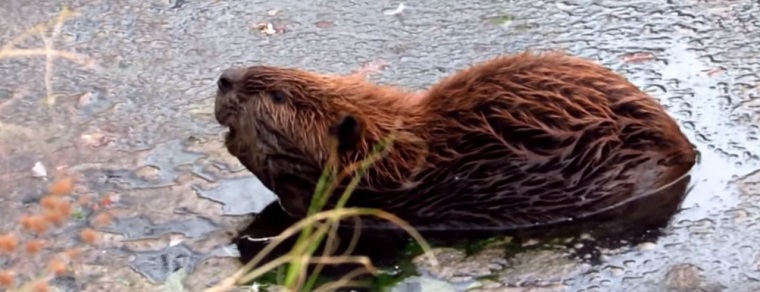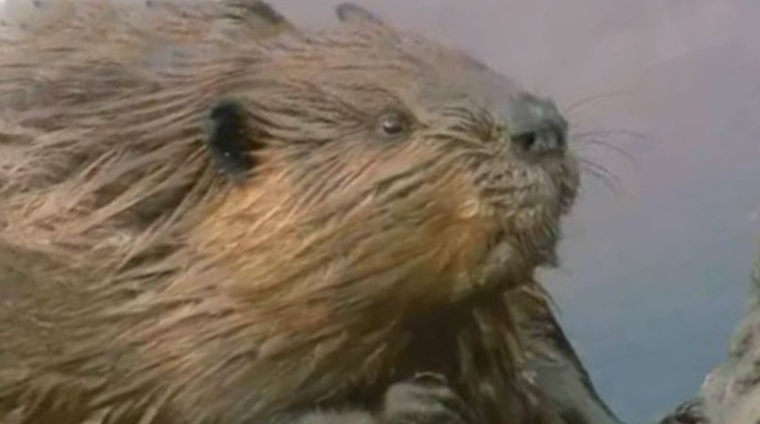-
info@aaanimalcontrol.com
Call us for help in your town
Humane Wildlife Education
Keeping beavers away from your own trees or plants
Need beaver removal in your hometown? We service over 500 USA locations! Click here to hire us in your town and check prices - updated for year 2020.
SHORT ANSWER: Wrap the base of trees with steel wire mesh that you can buy at any hardward store! Easy! You can just nail or staple it in place, or even just use the natural roll of the wire to wrap around the tree. Other plants are harder, and may require general fencing.
Before we start on the things you CAN try to get rid of beavers, we should first look at the methods you absolutely must not use to try and get rid of beavers. This includes poison, because it doesn't work and there isn’t a registered poison for an animal as large as a beaver that you buy commercially. This also includes trapping the creatures with the intentions of relocating and releasing them somewhere else. This is not usually not worth your time, money, or effort. To start with, the animal will more often than not die within a few days of you releasing the animal into the wild. The lucky ones that do survive almost never create a new den in the same area that they were released. If the beaver isn't released far enough away from the land on which it was trapped, it will just come right back. Removing one beaver alone won't solve your problem. Beavers form colonies that can run into double figures. Removing one just causes hard work for yourself.

Moving along from that idea somewhat, it is actually unlawful to release a beaver back into the wild once it has been captured in many states. The law dictates (in most places) that you can only release the animal on the land on which it was initially captured, which doesn’t get rid of your problem at all.
The best way to get rid of beavers is to look at methods that encourage them to politely wander off of their own accord. Destruction of the animal is one method of looking at things, but you will need to get in touch with your local city or county services to find out the trapping, release, and destruction regulations of a beaver. In many states across North America, the animal is actually considered to be a “furbearer”, and this comes with a number of regulations. Firstly, you'll need a permit in order to trap them or shoot them. Live traps CAN be used on personal property without a permit, but then you have the what-to-do-with-it-next situation. If you plan to use any other trap than a live cage trap to get rid of beavers, you will need to look at getting yourself a permit in most places.
You could always make sure that you are protecting the most-preferred plants and trees in your yard, but you must remember that beavers will often attack and chew at most tree and plant material, to use as material for construction if not for eating. There are certain trees and plants that beavers enjoy to eat the most, and these include:
- Willow
- Cottonwood
- Alder
- Aspen
- Birch
Aspen tends to be the favorite, but no plant matter is safe. They will also eat other trees — trees that are not deciduous. Coniferous trees are the second choice, usually pine and fir trees, but as we’ve mentioned, they will use the wood they chew off as construction materials if they don't like the taste of it much.
The harder you make it for the beavers to reach the areas they want to get to, the higher chance you have of them giving up and looking for whatever they’re looking for elsewhere. Woven wire fences are a good idea to protect trees and smaller areas of plants and vegetation. Larger perimeter fences can be erected around your land as a whole too, keeping all manner of wild critters at bay, both large and small.
If you do have a problem with beavers on your land, don’t take matters into your own hands. Fences can help, as can those mesh wire fence protection systems too, but a problematic beaver with a dam will need to be removed and trapped by a professional. That’s a legal obligation, and not just a humane one.
How to Stop Beavers Eating Trees
Need wildlife removal in your hometown? We service over 500 USA locations! Click here to hire us in your town and check prices - updated for year 2020.Stopping beavers from eating your trees really could be as easy as putting fences around them, if you intervene quickly enough. You should put preventative measures in place before the damage becomes too extensive, and if you live in an area that is rife with beaver attacks, it is definitely worth protecting your trees BEFORE they get hit. You know what they say — prevention is better than cure.

The aim of the game as far as learning how to stop beavers eating trees is concerned, is to prevent them from getting access to the tree in the first place. That's what applying fences to the bottom of tree trunks does — it provides a barrier between the beaver and the trunk.
Why do beavers chew trees?
There are actually quite a few reasons why beavers choose to chew the trees in your back yard. They build with the chewed wood, to start with, using it to build their homes, also known as beaver dams. As well as that, they eat some of the wood. They have their favorite trees, much like all animals have their favorite foods, and for the beavers, it's trees such as willow and cottonwood, poplar and aspen that are often the worst affected. These are the trees that you will focus your attentions on when erecting your tree fencing to keep the animals at bay.
What materials should I use to build beaver-proof tree fencing?
There are a few different types of material you can look at when you want to protect your trees from beavers. Chicken wire is a good place to start, but this can be very unsightly, as can all fencing. You must remember that chicken wire is not rust-proof. The longer it is left to battle the elements, the more damaged it will become, and the more rusty it will look. You will need to replace this regularly, should you choose to use chicken wire.
2 by 4 inch mesh wire is one of the best materials, and you can buy multiple rolls of this at hardware stores. It's considered to be slightly more aesthetically pleasing than chicken wire, and it's easy to buy and then work into the shape you need to protect your trees from beavers.
As well as the correct kind of fencing, you'll also need some thick gloves to protect yourself from sharp wire-ends, as well as wire-cutters to help you create the right shape and size of fencing. You will also need something to help keep your wire fencing in place, and wire fasteners or cable ties are good for this.
How to build beaver fences for trees
It's all very simple really — you simply create a cylinder of wire material around the base of the tree, making sure that the wire covers some of the base of the tree, bent so that it covers a bit of the ground around the tree too. The height of the cylinder will need to be around a couple of feet high, but you don't normally need to anchor the wire to the ground.
How to protect multiple trees
If you have lots of trees together that you would like to protect, you can do so using the same method but on a larger scale. The thing you need to remember with this is that beavers are very good at digging, so you will need to make sure you have inserted the wire mesh enough into the ground to protect the group of trees from underground, as well as on top of it. You will also need to allow for weather changes. In the winter, for example, when the snow falls, you may need to erect the fences a couple of feet higher than in the summer. This is because the snow compacts and raises the ground level, allowing the beavers to get over the barriers you have put up.
Electric fences to stop beavers chewing trees
You can buy solar powered electric fences now, and although expensive, can prove useful when fighting back against a particularly aggressive beaver hitting the trees on your land. These fences work when you want to protect a much larger patch of land and trees. It might prove to be cost effective to protect every tree with an individual fence, therefore protecting the entire plot with electrical-powered fencing offers a somewhat easier to manage option.
As with other types of beaver fences, these electrical ones will need to be regularly checked over to ensure they are full, working order, and may even require regular maintenance. If you need to hire someone to come in and do that, this cost will need to be considered.
Abrasive tree covering method to stop beavers chewing trees
Some homeowners have had great success protecting their trees from beavers by making up and then painting the tree with an abrasive paint. Beavers are reported to dislike this abrasive texture, therefore avoiding the trees that have been painted with it. There are pros and cons, of course, and some people have said this doesn't work at all. Much like most wild animal removal and prevention methods, nothing is 100% foolproof. You will also need to bear in mind this abrasive mixture might not look that great when painted across the bottoms of all your favorite trees. Certain mixtures can even kill off the thin bark of certain tree species, and that is even more so the case when you introduce cayenne pepper into the mix.
There are plenty of beaver protection methods you can install on trees but it is generally considered better to use a form of fencing. This is the method with the best results at keeping the animals at bay.
For more information, you may want to click on one of these guides that I wrote:
How To Guide: Who should I hire? - What questions to ask, to look for, who NOT to hire.
How To Guide: do it yourself! - Advice on saving money by doing wildlife removal yourself.
Guide: How much does wildlife removal cost? - Analysis of wildlife control prices.
animals in the attic
noises in the attic
Read more about How to keep beavers away from your trees or plants.
For more information, you may want to click on one of these guides that I wrote:
How To Guide: Who should I hire? - What questions to ask, to look for, who NOT to hire.
How To Guide: do it yourself! - Advice on saving money by doing wildlife removal yourself.
Guide: How much does wildlife removal cost? - Analysis of wildlife control prices.


















